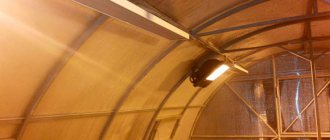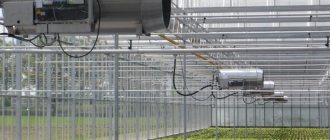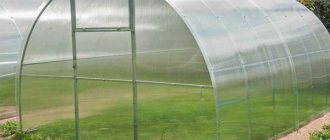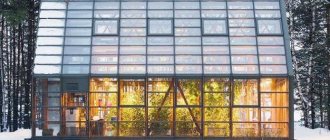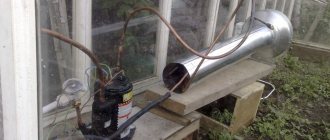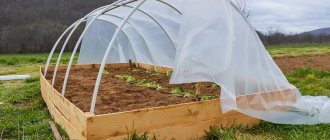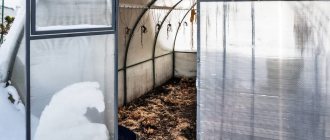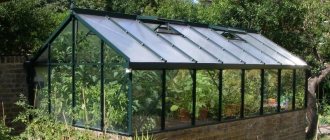Updated: 02/19/2021 18:37:11
Expert: Konstantin Borisovich Polyakov
*Review of the best according to the editors of expertology.ru. About the selection criteria. This material is subjective in nature, does not constitute advertising and does not serve as a purchase guide. Before purchasing, consultation with a specialist is required.
Growing flowers, vegetables and fruits in a greenhouse can be done year-round or from very early spring until late autumn thanks to the use of heaters. On the one hand, such equipment should not be expensive, because it will work in a greenhouse and not in a house. But on the other hand, the safety and reliability of the device is important so that the crop does not die and the greenhouse does not burn down. These are the models available for purchase in the Russian Federation that our experts selected.
Operating principle of IR heater
Infrared heaters differ in operating principle from other devices; they heat not the air, but the surrounding objects, that is, they act on the principle of sunlight.
Diagram of heat distribution in a greenhouse.
When taking pictures of the situation in a room with thermal cameras using infrared devices, you can observe the following picture: the maximum temperature is observed near the equipment and near the floor surface, that is, heating is felt immediately after switching on. But with a conventional heater, warm air rises to the top, that is, you have to wait a very long time for the temperature below to rise, and this significantly increases energy consumption. That is, we can conclude that infrared heaters are much more economical; it is recommended to choose them when electricity consumption is critical and comfort is a priority.
Lamp and film heaters with minimal energy consumption
To install an effective and simple IR heater, ceiling lamp and film structures are often used, which are very easy to install and their energy consumption is quite economical.
Diagram of a lamp IR heater for greenhouses.
Lamp infrared devices use halogen lamps with a tungsten filament in a flask filled with a mixture of argon and nitrogen as a radiation source. The power of such lamps is 150-250 W, which is quite enough to heat an ordinary living space. Lamps for such devices are produced in different ways:
- conventional infrared mirrors, which are similar to conventional lighting lamps, but emit a larger amount of IR rays;
- mirror red infrared lamps with a bulb made of dark red glass, they give little light, but more heat, and energy consumption is much less.
Film infrared heaters are attractive because they do not have a housing, that is, they are a film with carbon paste one micron thick. This film has copper contacts. You can choose such a heater if you need to heat the device to a maximum of 110 degrees, and the average heating temperature is 30-45 degrees Celsius. The energy consumption of a film heater is not very high; it is often used for installation not only on ceilings, but also for floor heating.
Gas panels and long wave IR
Gas IR heaters are mainly used for local heating of small outdoor areas. This allows you to create comfortable conditions on verandas, outdoor cafes, and terraces. Often gas appliances are designed in the form of elegant modern lanterns that serve as design decoration.
Types of IR radiation.
The device itself consists of gas cylinders hidden under the base of the umbrella. The consumption of the cylinder is very economical, it lasts for 22-25 hours of continuous operation, so they are often taken on picnics, placed on playgrounds, sports grounds, and parks. There is enough power to feel comfortable even at sub-zero temperatures.
Gas ceiling heaters are used when a mobile heat source is needed on an area from 9 to 60 sq.m. The fuel is bottled liquefied gas.
Most often, long-wave devices are used to heat a house, the radiation source of which is a special aluminum alloy plate with a special coating. Such a plate is heated by heating element up to 300 degrees Celsius, between it and the body there is a heat-insulating material that ensures heating of the body itself to only 50 degrees, that is, the heat is directed exactly where it is needed.
Household IR devices of this type are produced in the form of rectangular cases; they are mounted on the ceiling with special brackets; the angle of inclination of the device can be easily adjusted. Long-wave devices are very convenient for heating not only in residential premises, they can also be successfully used for offices, shops, and kindergartens.
Kinds
IR heaters are extremely popular despite their rather high cost.
There are many models of different power, for different areas, on different fuels, and so on. According to the installation method, devices are divided into 2 types^
- Stationary - the presence of a heater in this case is provided for at the construction stage. This solution is rational in the case when the greenhouse needs constant heating and has an area of at least 15–20 square meters. m. Otherwise, a mobile model is quite sufficient.
- Portable - designed for heating a small area - up to 15 square meters. m. The heater can be moved from place to place or mounted on suitable surfaces.
IR heating by power type
- Electrical - thermal radiation is generated by a special element. For this to happen, it must be warmed up. In electric heaters this occurs due to electric current. Based on the type of heating element, the following types are distinguished: ceramic – the heating element is a ceramic panel. Its large area guarantees heating of a large area of the greenhouse. Ceramics are practically eternal and do not react to temperature changes. Another interesting property is that the ceramic element does not glow in the dark. The disadvantage of the device is that it takes a rather long time to warm up - up to 15 minutes;
- halogen – the heat source is tubular quartz heaters. This option heats up much faster, but is designed for a smaller area. Performed in any version - floor, wall, ceiling;
- carbon - heat is generated by a quartz tube, inside of which there is carbon fiber. This model is very durable and effective: almost all models are equipped with reflectors. On average, a 500 W model warms up an area of 10–12 square meters. m;
- micathermic - ceramic tubes serve as the heating element. This is the safest option among all electric heaters. This structure is best suited for wall and ceiling units.
- Gas - gas is used to heat the element, which emits infrared radiation. There are 2 types of devices:
But in order for the heat to reach the beds in full, it is worth understanding how to make beds in a polycarbonate greenhouse.
Film - or tape. The heating elements are fixed to foil, which acts as a reflector and is covered on both sides with a laminated film. The thickness of the tape is only 1.5 mm. In rooms, a film heater is usually installed on the floor, but there are ceiling models. They are ideal for greenhouses. The film heater creates uniform heating, does not dry out the air, does not require maintenance and is easy to install.
This is what a strip infrared heater for greenhouses looks like
Devices are also classified by type of radiation:
- light – heat up to 600 C. Models are used for greenhouses with a large area;
- long-wave - they heat up to above 300 C. This power is enough for heating small greenhouses.
Also, don’t forget about how to install it yourself and use it correctly to ventilate a greenhouse.
This parameter distinguishes between:
- models with a thermostat - the device allows you to set and maintain the radiation power, which, in turn, provides heating or temperature maintenance. However, they do not estimate air temperature or humidity;
- options with a thermostat - provides for turning off the heating when a certain temperature or humidity is reached. The thermostat can maintain the temperature according to the set schedule.
Types of heating systems for polycarbonate greenhouses
The simplest solution to the issue of organizing additional heating in a greenhouse may be to install a conventional stove in the room. In this case, the stove is built in the middle of the room, the chimney is brought outside, and wood, coal, and peat are used as fuel. In order for the plants to feel comfortable, a simple ventilation system is installed. It would seem that this method is quite simple and affordable to implement, but the main disadvantage of stove heating is that it is impossible to achieve uniform heat distribution over the entire area of the greenhouse. Therefore, plants located closer to the stove receive an excess of heat, while their more distant counterparts receive a lack.
Some summer residents are trying to install electric heating in the greenhouse. To do this, they install various heating elements, convectors, and fan heaters around the perimeter of the greenhouse. Also, cable heating systems for greenhouses are widely popular, which ensure uniform distribution of heat throughout the entire volume of the room; installation and subsequent maintenance require a minimal investment of money. Electric greenhouse heating systems can be connected to an automatic controller, which will adequately respond to changes in air temperature outside the room, maintaining a predetermined temperature in the greenhouse. Those wishing to install electric heating in their greenhouse should not forget that they must pay for electricity. The cost of paying for electricity to heat the air in a greenhouse directly depends on the type of heating element chosen, so electric heating is not always justified from an economic point of view.
The most acceptable way to heat a greenhouse is to use infrared heaters. Infrared heaters do not heat the air in the room, they only warm the plants. Moreover, infrared heaters do not emit light and consume a small amount of electrical energy, which justifies their use even in small greenhouses.
Type ECL-I 500 W
A special feature of the infrared heater type ECL-I 500W is its manufacturing basis. It is produced on the basis of ECS ceramic emitters having a spherical surface. This design makes it possible to remove the emitter from the heating surface.
The main technical parameters of the heater are:
- power – 500 W;
- voltage – 220 V;
- dimensions – 280x210 mm.
Methods for placing a heater type ECL-I 500 W
Heaters must be located in the greenhouse at a height of no closer than 1 meter to the ground surface. When the plant converges and grows rapidly, the heater should be gradually raised. A heater of type ECL-I 500 W is installed on a rigid base. This makes it possible to adjust the height of the suspension.
Based on the power of this heater, it is important to install it not in the center, but closer to the walls of the greenhouse. This will help maintain the room temperature
Quantity
Depending on the area of the room, heaters are installed in the amount of 1 piece every 1.5 meters. The higher the emitter is suspended, the larger the surface area it emits. But this also leads to the fact that distant plants receive less heat rays. It is an excellent solution for small greenhouses, and for larger ones 2-3 heaters are used.
The price of this type of heater is in the range of 900-1100 rubles.
Installation of ceiling heaters
A small infrared ceiling heater for domestic use can be easily installed with your own hands. This can be done by a professional electrician or an ordinary person, the main thing is to follow all the steps exactly. You need to start with the correct placement of the equipment; you cannot place the device less than 30 cm from the furnishings and structures of the room. Now you need to decide what is included in the kit of a regular ceiling heater:
- the infrared device itself (this can be of any design, including glass panels);
- device suspension elements;
- heating electric heating element;
- heat-emitting plate;
- fasteners, tension plate;
- screws, bolts, etc.
Diagram of an IR lamp for a greenhouse.
Often, heaters for installation on ceilings come with all the necessary fasteners, these can be cables, chains, etc. In this case, it is possible to ideally determine the height of the heater and, if necessary, adjust it.
Installation steps include:
- first you need to choose the installation location, mark it with a simple pencil;
- then the infrared heater is pulled out of the packaging and placed on a horizontal, flat surface with the plate facing down;
- a ring screw is screwed into the ceiling, chain links are hung for fastening, and their reliability is checked;
- the heater is suspended on a chain at the selected height between the brackets (all screws must fit into the prepared grooves, after which they are screwed tightly);
- the heat-emitting plate is wiped with alcohol just before connection;
- the ends of the cable are connected to the heater and the fixed network in strict accordance with the diagram provided by the manufacturer;
- the device with the thermostat should be located approximately 1.5 m from the floor level; the device itself should not be in the field of action of the heater rays, in a draft or near other heat sources.
There are other installation options, for example, using terminals for glass heaters. These household appliances are a decorative panel made of tempered glass, which is attached to the ceiling using a terminal block and self-tapping screws
There are gas heaters, the installation principle of which is also different, so when purchasing, always pay attention to how exactly the device will be mounted, whether you have the conditions for its installation
Infrared heaters today are used not only for heating a private home, but also for shops, cafes, industrial workshops, even for open spaces. Not all heating devices are capable of this. At the moment, this is the most promising type of heaters, which have a variety of advantages.
During installation, you can maintain the shortest length from the device itself to structures and furnishings, that is, IR heaters are absolutely safe. Manufacturers today offer us various models, including gas appliances for ceiling mounting, industrial and household, and outdoor. The devices themselves can be made of special film, glass, and have various heating elements. Installing household IR devices is also very simple; usually, installing ceiling mounts is sufficient; the device itself is fixed using special brackets, terminal blocks, or suspended on chains and cables.
Rules for heating greenhouses with infrared devices
Such equipment is very easy to install and connect, so you can handle this work yourself. But it is necessary to follow the recommendations of specialists. For example, installing heaters near windows and doors can reduce heat loss. When organizing heating, you need to focus on the power of the devices.
Devices that have special mounts to the ceiling are easy to use. Such heaters can, for example, be hung above the table where the seedlings are located. But it’s difficult to say at what height the device should be – you’ll have to find out from your own experience. Once the heater is installed at a certain height, it should not be moved until plant growth begins. When the crops rise, the infrared heater for the greenhouse will need to be hung higher. If it is not possible to attach the device to the ceiling, you can fix it on a rigid base.
As for the number of heaters, there should be one device for every 1.5-3 meters of area. The distance between them depends on the size of the greenhouse and the height at which the devices are located. The higher the device is located, the larger the area it heats. Therefore, if possible, heaters should be installed higher, then fewer of them will be required. However, we must not forget that the higher the device is, the less heat the plants receive. Still, it is better not to save, but to proceed from how much more comfortable it will be for the crops.
You can also use 250W devices. In this case, more devices will be required to achieve the optimal temperature. The distance between them should be 1.5 meters. The height of their placement above the plants will also need to be determined from your own experience. The position of the heaters should remain the same until the seedlings begin to grow. Gradually, as the plants grow, the devices are raised to greater heights. Heaters of such power are small in size and weight; they are simply hung on wires. The height of the devices is very easy to adjust - just pull or release the wire.
There are some recommendations that will make infrared heating for greenhouses as efficient and economical as possible. For example, they can be arranged in a checkerboard pattern - then the room will be evenly heated over the entire area, and energy consumption will be less. In this case, the number of unheated areas will be minimal. However, this advice can only be used if you need to heat the entire greenhouse evenly. If it is necessary to create different temperatures in different parts of the room, you should not follow this recommendation. In this case, you need to install heaters in those places where you need to achieve a higher temperature regime.
Heating a greenhouse with an infrared heater, watch the video:
Where can I buy
There are many options. These are construction stores, specialized trading platforms for gardeners and summer residents, or stores selling electrical appliances and equipment. At any of these points the product can be seen and touched. In addition, a face-to-face purchase allows you to avoid purchasing a counterfeit. It's easy to calculate. Electrical appliances are always sold with a warranty period, during which service centers will repair the faulty device free of charge. "Left" companies do not provide guarantees for their products.
If for some reason this option does not suit you, you can always order the product online in an online store.
Advantages of infrared heaters
An infrared heater is a piece of equipment that produces rays similar to the sun. Objects and surfaces absorb them, and they, in turn, give off heat to the air. Sunlight gives exactly the same thermal effect.
Thanks to this, infrared heaters have the following advantages:
- low power with high efficiency, which allows you to save on electricity;
- practicality in operation;
- do not create drafts;
- distribute heat evenly throughout the room.
Using convective heating devices, you can notice that heated air rises upward, while cold air remains below. Such devices are ineffective in heating greenhouses, since the plants are located just below, and they will not have enough heat. Infrared heaters for greenhouses are good because they evenly distribute heated air, thereby creating optimal conditions for plant growth.
Also, IR devices can eliminate drafts, which are undesirable for many vegetables and herbs. To do this, you simply need to place the device in an area where there is poor thermal insulation - during operation it will eliminate heat loss without creating air movement. Infrared batteries have high efficiency.
These devices are highly practical. Their advantage over other heating devices is the ability to divide the room into zones, setting a special temperature regime in each. While highly efficient, infrared heaters are economical: if installed and used correctly, you can reduce energy consumption by 40%.
These devices allow you to warm the soil to a depth of 5-7 centimeters, and this stimulates the root system of plants and creates the required conditions for successful development. Other heating devices cannot purposefully heat the soil. IR rays warm the ground to 28 degrees – the optimal temperature for plant growth. At the same time, the air temperature in the room itself is about 21 degrees.
Also, infrared devices are safe to use, so they can be left on unattended, setting the desired temperature level.
Main advantages
The design of such devices is ceramic infrared lamps, which are located in a frame made of highly polished metal. They work by producing rays very similar to sunlight. In other words, such devices create an imitation of the sun's rays and their heat. When these rays hit objects or any surface, they are quickly absorbed, and then the thermal energy is transferred to the surrounding space.
An important feature of infrared heaters is the coverage of a large area by such rays when the source of thermal energy is removed from the heated surface. In this case, the heating temperature of the heated surface will decrease
In addition to thermal energy, which is very similar to solar energy, fan heaters have the following advantages:
- Best distribution of thermal energy. In other words, uneven distribution of heat is completely eliminated, unlike other types of heaters, in which warm air is at the top and cold air is located near the floor surface. When growing seedlings, this property can be considered a big disadvantage. The infrared heating system does not heat the air space, but only the necessary areas of the polycarbonate greenhouse. Thus, the air in it will always have an optimal temperature for plants.
- Great practicality. It lies in the fact that when using a large number of fan heaters, you can create several different areas in one room. At the same time, it is possible to set the optimal temperature for each individual zone.
- Economical use of electrical energy. With high-quality installation of infrared lamps, you can achieve savings in electrical energy consumption of up to 45%, because it will not be used to heat unnecessary space.
- When the infrared heater is operating, there are absolutely no drafts. By installing such heaters near windows, it becomes possible to compensate for heat loss without much air movement.
Heating polycarbonate greenhouses in winter: heating options
Thanks to the vast experience of agricultural workers in the use of infrared devices, we can highlight the following recommendations that will help you choose a quality product:
- seed germination increases by 35 percent when using infrared lamps in polycarbonate greenhouses;
- the microclimate in the room is not disturbed and has optimal humidity under the influence of infrared rays, which eliminates the problem of regulating air humidity;
- infrared heaters operate very quietly and do not emit any odors;
- heating the soil to a depth of up to 8 centimeters is possible, which other types of devices with a heating function cannot achieve;
- you can warm the soil in a polycarbonate greenhouse up to 30 degrees Celsius using infrared heaters, and at this time the room temperature will not exceed 22 degrees Celsius.
Thus, it becomes clear that infrared heaters are a very profitable and useful purchase for a greenhouse. To decide on the choice of an infrared heater for a polycarbonate greenhouse, you need to know their following features:
- Light infrared heaters can heat any surface up to 550 degrees Celsius and are optimally suited for industrial premises with a large area.
- Long-wave infrared heaters do not have such great potential, so they are well suited for small rooms, which are found in most garden plots.
- Many models run on electrical energy, but you can find gas units that use natural gas.
How to do infrared heating in a polycarbonate-based greenhouse with your own hands
In order to equip a polycarbonate greenhouse located on a summer cottage or suburban area with infrared heaters, it is not at all necessary to attract expensively paid specialists. All work can be done independently. The only condition: if you do not have the skills to work with electrical equipment and do not know the basics of electrical safety, it is better to involve a professional in the work related to connecting infrared radiation sources to the network.
— 2-4 ceiling heaters should be installed in the upper part;
— in the lower part, to effectively warm the soil, you need to install film-type heaters.
In order to achieve maximum effect from the operation of ceiling heaters, a concrete path should be installed in the middle of the building, under the location of the IR devices. It will accumulate the heat generated at the top and distribute it evenly throughout the entire volume of the room. Film heaters buried in the ground will warm the soil from below.
To install film heaters, it is necessary to remove the top layer of soil to a depth of 40-50 cm. Sand should be poured into an even layer at the bottom of the resulting trench. Next, any heat-insulating material that has a low moisture absorption coefficient is placed on the sand bed. Foamed polystyrene can be used for this purpose. The purpose of this insulating layer is to retain heat and prevent it from penetrating into the ground. Next, after the polycarbonate or other similar insulation has been laid, it must be covered with another layer of sand 5 cm thick. The sand must be watered and then compacted thoroughly.
Then, an infrared film heater is laid on a layer of compacted sand. Before laying the heater, do not forget to connect the power wires to it and lead them outside the trench. After laying the film infrared heater, its surface is covered with another layer of sand, which is watered and compacted to remove air bubbles. If air bubbles are not removed, they will act as unwanted resistance in the heat path. Then, a perforated sheet of asbestos cement or a metal mesh is laid on a layer of sand, which will protect the heating element from possible mechanical damage that may occur during digging up the soil inside the greenhouse. Next, the remaining space of the trench is filled with ordinary fertile soil.
How to choose an IR heater for a greenhouse
Of course, it should be taken into account that positive reviews of IR heaters were received from people who were able to choose the right device for their greenhouse and install it properly. The maximum positive effect from the operation of the device depends on the accurate calculation of the heating systems, connection and location.
So, to explain everything simply and quickly, let’s consider the calculation using the example of a standard greenhouse with dimensions of 6x3 m. For such an area, only two heaters with a power of 1.2 kW to 1.5 kW are enough
But it is important to consider not only the power, but also the size of the devices themselves. For example, a device about 1.8 m long with a beam dispersion angle of 100-120 degrees is capable of heating an area measuring 2.5x3 m
Even the roughest calculations will make it clear that two heaters are more than enough for the greenhouse taken as an example. Of course, larger areas will require more heaters or more powerful models.
For wide greenhouses, there is another option - to install heaters not in the center, but on both sides. To do this, you will need about 4 devices, and their power should be halved accordingly. This way you can be absolutely sure that every square centimeter of space is exposed to the warm rays.
Types of heaters
There are several types of IR for greenhouses. The types of radiation by nature and length were described above, but now the difference lies in the installation method.
Types of devices by installation type:
- ceiling - the optimal location is a meter from the ground surface. Best suited for greenhouses with high humidity levels, creating an additional greenhouse effect;
- ground - placed directly on the ground;
- wall;
- infrared films – can be installed on the ground vertically or horizontally. Vertical installation is carried out between the beds when the film goes around the entire perimeter. When installed horizontally, the film is dug into the ground to a depth of approximately 50 cm under the beds. This method is more suitable for a stationary greenhouse, when you do not need to regularly dig up the beds.
Calculation examples
Condition: The equipment will be installed at a height of 1.7 m. At a distance from one to another - 3 m, in a checkerboard pattern.
Question: How many infrared heaters will be needed with such an installation for a greenhouse measuring 6 by 12 m and an area of 72 m2?
Solution: If we multiply 3 (m.) by 4 heaters (power 7.5 watts), calculating that each of them can serve three meters of area, then we get 12 heaters.
For a greenhouse 3 by 6 m, two IR heaters 1.7 m long and 3 m wide, with a power of about 1,000 W, are enough.
From these examples it is clear that it is necessary to take into account not only the area of the greenhouse, but also their type and the power of the equipment. The more intensively it works, the fewer devices you will need.
general information
When growing garden crops in a greenhouse, it is necessary to pay special attention to the microclimate. Regardless of the time of year and ambient temperature, comfortable conditions must be present inside the building under which the growth, development and productivity of plants will be most productive
And no matter what type of heaters will be used, it must perform its basic functions in the best possible way.
Infrared heaters imitate sunlight
Some gardeners set up heating systems with their own hands, building small solid fuel stoves. However, such inventions are not known for their safety and require constant monitoring and addition of fuel. In addition, they heat only the air, which is why the efficiency indicators are seriously reduced. Often, pipes with water are supplied to the structures, which are located around the perimeter of the greenhouse. Unfortunately, this approach does not improve heating productivity, but only requires large investments.
The next type is electric air heaters. They are easy to install and also support full automation, which makes them comfortable to use. Unlike the previous type, such systems do not heat the air, but they also do not boast a high level of efficiency.
Among the advantages of electric-powered fan heaters for greenhouses are instant heating of the interior space, although this leads to one unpleasant phenomenon - excessive drying of the air. In turn, dry air negatively affects green spaces and reduces yields.
The most unsuitable heater option is a gas appliance. When operating such a system, any air humidity drops to minimum levels, which entails disastrous consequences for the crops grown.
Also, when arranging electric heaters for greenhouses, soil heating cables are considered. They are capable of warming up the root system of plants, but are expensive and require expensive maintenance.
In this video you will learn more about infrared heaters;
The selection criteria depend on you ↑
Traditions of our grandmothers
By and large, this is actually true - everything (or almost everything) depends on your own requirements and conditions. So, in early spring, on days when the seedlings in greenhouses are slightly frozen, some gardeners like to use large candles placed between the rows and beds of seedlings. And this is really quite enough for small greenhouses, where they grow dozens, or even hundreds of bushes.
To equalize temperature at night, heated bricks and hot water in containers are sometimes used. Several bricks and a bucket of water are placed in the greenhouse at dusk and left until morning. By giving off their heat, these objects prevent the night temperature from falling to critical levels. Such traditional methods are still quite applicable today. Although more efficient farms strive to acquire modern equipment that provides more significant advantages.
Fan heaters
They were appreciated due to the convenience of quickly pumping warm air into the space. But their disadvantage, which consists in excessive drying of the air and uneven distribution of heat, cannot be ignored.
Gas appliances
Many consider them to be one of the worst options for greenhouse heaters. They are based on a gas pipeline and a regulatory system. The air is heated using a heat generator, and, being already at altitude, is supplied to the greenhouse. The big disadvantage of this system that has not yet been overcome is the excessive dryness inside the greenhouses, which is detrimental to plants.
Oil heaters
These are considered not at all rational for these purposes. They spend too much energy that it does not pay off in the resulting harvest. In addition, they take up useful space, because it is not recommended to plant plants next to them either. And experts also call drops of condensation possible in greenhouses a risk factor for oil heaters.
Ways to improve the efficiency of a heating system
As you know, infrared heaters do not heat the air, but objects, including the soil of the greenhouse. At the same time, they are only able to warm the soil by 7-10 cm, and as plants such as cucumbers grow, the soil receives less heat. Therefore, to increase the efficiency of the heating system, experienced vegetable growers recommend that the soil be heated. The following options are possible:
- supply of warm air from any source through pipes;
- traditional cable “warm floor”;
- laying a layer of penotherm between the foundation and the ground;
- laying PLEN IR film under the ground.
Penotherm is an effective and inexpensive material for thermal insulation of greenhouse soil
Penotherm is widely used as insulation for saunas and baths. It is also the most cost-effective method of thermal insulation of greenhouse soil. A material with a thickness of 0.5 cm is used, which is laid directly on concrete with an overlap on the walls of the greenhouse to a height of 10-15 cm. A layer of soil up to 50 cm thick is poured on top of the insulation. This “pie” tolerates frosts of 30-40 ° C well.
Infrared film can be laid under the ground to a depth of 30-50 cm in stationary greenhouses or used for temporary heating, covering plants from above only on very cold days. The film under the ground can be mounted either horizontally on a base of concrete or crushed stone, or vertically along the perimeter or between the beds. Film heaters are also convenient when growing seedlings in boxes on shelves or on the floor.
Infrared film can be used to “bottom” heat the soil of a greenhouse or cover plants from above during very cold periods
When placing IR units in a greenhouse, it is also useful to take into account the recommendations of experienced users.
The potential of infrared heating devices with a power of 500 W or more is fully realized when they are placed in the coldest zones of the greenhouse along the walls and windows. Moreover, the distance from the device to the plant should not be less than 1 meter. Powerful heaters with ceiling mounting are effective. They are placed above tables with seedlings, above tall plants in the ground, but the optimal placement height in each case must be determined experimentally independently.
Typically, 1 heater is installed for every 1.5-3 meters of greenhouse length. The higher the greenhouse ceiling, the larger the area covered by one device. True, the higher the unit is located, the less heat the plants receive.
For some plant growers, the infrared heating scheme for a greenhouse with 10-12 heaters with a power of 250 W seems more flexible. It allows you to concentrate more appliances in one zone, leaving another cooler. In this case, the distance between the heaters should not exceed 1.5 meters, and the height of their placement above the plants is also determined experimentally: first they lower them lower, and raise them as they grow.
To increase the efficiency of an infrared heating system and at the same time reduce energy costs, the heaters are placed above the plants in a checkerboard pattern, thereby reducing the number of “dead” zones.
An example of organizing infrared heating of a greenhouse based on 3 units with a power of 1000 W in the video:
Users note the only drawback of infrared heating of greenhouses is the cost. But plants with rapid growth and high productivity fully compensate for these costs.
The best manufacturers
The heater is chosen for more than one season. When you give your hard-earned money for an electrical appliance, you want to be sure that it will last long enough. The world's best manufacturers, whose popular models do not require additional advertising, can guarantee high quality.
Ballu
Many buyers have managed to appreciate the products of this international holding, a world leader in the production of climate control equipment. The company's product range includes more than three hundred items of household and industrial equipment:
- humidifiers and dehumidifiers; coolers and heaters;
- convection, infrared, ground, water, gas heaters;
- hand dryers;
- air conditioners, split systems, etc.
It all started at the end of the 20th century with a small company producing refrigerators and freezers BLR “Bai Lunyu Refrigerated Equipment Entertainment” in the town of Keelung near Taipei, the capital of Taiwan. Today it is a multinational corporation headquartered in Hong Kong.
MO-EL
The Italian company Moel by SALKA specializes in the production of pest control products. At the same time, climate control devices have been developed and produced: IR heaters, hand dryers, hair dryers, heating equipment, etc. The functionality of some models can be supplemented with various devices, incl. air ionizer. The popularity of the company's models is explained by the constant search for new technical solutions.
Timberk Tech
The Swedish manufacturer is a recognized leader in the production of climate control equipment. The company's products undergo rigorous quality control at each processing stage. The latest technologies are used in the production process. Buyers highly value products bearing the Timberk brand for their high quality, affordable prices and the regular appearance of new products on sale.
Electrolux
A Swedish company known throughout the world for its high-quality household appliances. All housewives know her products. These are washing machines and dishwashers, irons and steam generators, vacuum cleaners and kitchen appliances. Among all this diversity, there was a place for all kinds of heaters, convection, infrared, etc. Users note the high build quality and excellent design of Electrolux products. In 2014, the company supplied equipment to hotels in Sochi, in preparation for the Olympic Games.
SST Group of Companies
“Special systems and technologies” is the abbreviation for the SST group of companies. Specialization – heating cables and electrical heating systems, industrial and domestic. Here are sets of heated floors and systems for heating pipes, deicers. The largest manufacturer of such products in Russia. In terms of production volume, it is one of the largest in Europe. SST (more than 1000 items).
Green Box Agro
The brand belongs to the SST group of companies. Produces sets of ground heating systems: consisting of: cable of various lengths, temperature controller. Purpose – heating the soil in greenhouses of various sizes.
Heatline
Russian manufacturer of heating cables: resistive, self-regulating, ultra-thin. With the help of equipment produced by the company, industrial tanks, containers, and pipelines are heated. The company's engineers constantly solve problems to improve the energy efficiency of their designs.
Sokol-Electro
Domestic manufacturer with a rich history. In 1877, Russian Army Colonel Boris Ivanovich Wiener founded the Ekaterininsky Powder Factory. By the beginning of the 20th century, the company became the largest private supplier of gunpowder for the Russian army. One of the company's shareholders was Emmanuel Nobel, the father of the future founder of the most prestigious prize in the world. Today the company produces electrical products, including heating tapes, which are in demand among greenhouse owners.
Thermophone
Russian company. On the market for more than 20 years. Specialization – development and production of budget infrared emitters. The company constantly uses innovative technologies in its models. The head of the enterprise has a scientific degree in the field of application of IR emitters in agriculture. The company's products can be used to heat large areas.
Soft Term
Domestic manufacturer of low-temperature IR heaters. The company is the owner of the STEP brand. The company provides a full range of services at the buyer’s request:
- will analyze energy consumption at the customer’s site free of charge;
- will perform calculations of power and payback period;
- optimizes the layout of heaters;
- will ensure delivery of equipment to the site.
Supra
The Japanese corporation is one of the recognized world leaders in the production of consumer electronics. Its products are in demand all over the world, thanks to the successful ratio of high quality and affordable prices. The company was founded in 1974. Today it is an international concern with production facilities around the world.
Hyundai
A well-known South Korean company known as a car manufacturer. However, models of convectors, IR emitters, fan heaters, etc. are widely represented on the climate technology market. They are popular among buyers due to their high-quality assembly, innovative technical solutions and affordable price.
There are enough companies on the market that produce high-quality heaters of various types. The buyer decides which company equipment is best to buy, taking into account his financial capabilities.
In any case, you should listen to the advice of experienced users, recommendations of sales consultants in specialized stores, find out how much a suitable model costs, carefully study the description and step-by-step operating instructions. All this information will help you avoid making mistakes when choosing a heater for your greenhouse.
Variety of IR heaters
Today you can choose a wide variety of infrared heaters, which are divided into:
- Low temperature ceiling infrared (long wave) models. The heating of such devices ranges from 100 to 600 degrees; they are used for residential premises where the ceiling height is no more than 3 m. The electricity consumption of such devices is very economical, and the atmosphere in the room is comfortable and pleasant. The air does not dry out when used.
- It is better to choose medium-temperature infrared (medium wave) when it is necessary to heat a room with a ceiling height of 3 to 6 m. The heating temperature ranges from 600 to 1000 degrees, such equipment is excellent for large residential and non-residential premises, restaurants, cafes.
- High temperature infrared (short wave). Such devices heat up to temperatures of 1000 degrees; they are used for installation in production workshops, warehouses, and stores where the ceiling height is from 6 to 8 m.
